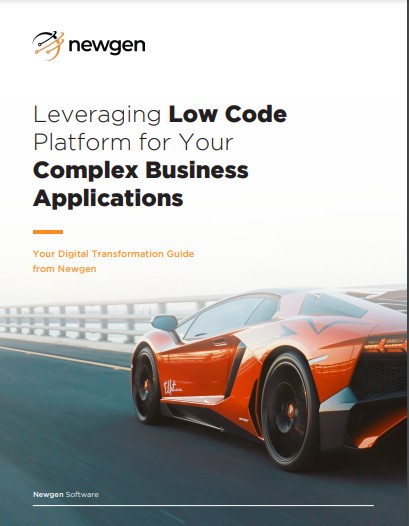The Fastest Path to Simplifying Operations and Driving Strategic Agility
Digital transformation remains the highest priority for enterprises seeking growth, efficiency, and competitive advantage. While the goal is clear, the journey has become increasingly complex. Organizations today face rapidly shifting market demands, diverse customer expectations, and an explosion of operational data. Traditional approaches to building and running business applications are no longer equipped to handle this complexity.
This whitepaper emphasizes why modern enterprises must adopt a new way of building and scaling digital capability. Low code platforms deliver the agility needed to automate complex workflows, unlock insights from content, and rapidly deploy new applications that support evolving strategy.
The Challenge: Complexity Everywhere
Enterprise applications have become more demanding and more varied. Organizations must manage:
- Multiple channels and endpoints
- High-volume transactions with strict regulatory controls
- Frequent business rule changes
- Disjointed systems with limited integration
- Unstructured data across content-heavy environments
- Distributed operations spanning many roles and locations
These factors make agility difficult and slow down response to change.
The result is a growing gap between business expectations and technology capability. Complexity stalls innovation, increases operating costs, and creates technical debt that becomes harder to manage over time.
What Makes Applications Complex Today?
The paper breaks down several sources of complexity that challenge even the most tech-forward enterprises:
- Multiple Touchpoints
Customers engage across physical and digital channels, requiring constant synchronization. - Holistic Customer Journeys
Every interaction must be contextual, personalized, and fully connected. - Urgency for Speed
Business-critical processes that once took days must now be completed within minutes. - Variety of Roles Involved
Collaboration needs increase exponentially with each added function or stakeholder. - Heterogeneous Applications
Legacy systems and new tools often operate independently, creating data and process silos. - Personalization Requirements
Dynamic decisions demand flexibility in workflows, rules, and document management. - Expanding Data Models
Deeper entity relationships mean more information must be processed instantly. - Unstructured Content Growth
Documents, messages, and multimedia now make up the majority of information processed. - Constant Policy and Rule Changes
Adaptability is necessary to avoid workflow breakdowns and compliance exposure. - Scalable Volume Demand
Rising transaction loads require automation that does not buckle under pressure. - Work-from-Anywhere Operations
Hybrid environments require secure, digital-first processes that remove dependence on physical access.
Organizations must transform internal processes to deliver external simplicity.
Why Legacy Approaches Cannot Solve Modern Challenges?
Point solutions add more silos. Fully custom development takes too long. Neither approach delivers the speed and flexibility needed today. When business applications cannot change fast enough, opportunities are lost and inefficiencies multiply.
The need of the hour is a unified platform approach that supports intelligent automation, scalable content governance, and connected communication — all configurable at high speed.
The Power of a Unified Digital Platform
To simplify operations, enterprises must unify three core pillars:
- Process — End-to-end workflow automation with analytics and governance
- Content — Smart capture, contextual access, and timely information flow
- Communication — Omnichannel engagement that improves collaboration
When these pillars work together, enterprises gain visibility, agility, and operational control.
Why Low Code Unlocks Simplicity and Speed?
Low code brings rapid application development into the hands of both IT and business teams. It reduces complexity through:
- Visual design tools instead of manual coding
- Reusable components for faster deployments
- Ability to modify applications continuously
- Governance guardrails to prevent risk or duplication
- Integration accelerators that reuse existing systems
- CI/CD enablement for ongoing updates
Enterprises avoid accumulating more tech debt and eliminate scattered tools that slow progress.
The Low Code Advantage for Complex Businesses
Low code enables:
- Rapid development without compromising quality
- Automation of content-driven, mission-critical processes
- Consistent user experience across all journeys
- Central governance preventing shadow IT
- Fast scaling without major re-architecture
Innovation becomes continuous rather than episodic.
Real-World Impact
The whitepaper highlights examples such as a US-based financial firm that consolidated over 180 workflows into 13 optimized digital processes. Through automation and centralized content governance, millions of documents became easier to access and validate. The organization achieved massive improvements in speed, employee productivity, and end-to-end operational visibility.
This demonstrates how low code transforms business complexity into competitive advantage.
Low Code: The Future of Digital Transformation
A strong low code platform supports innovation across:
- Customer onboarding
- Service requests and case management
- Lending and deposits
- Finance and shared service operations
- Underwriting and complex decisions
Business teams gain agility, IT retains governance, and the enterprise delivers seamless digital experiences built to adapt to market evolution.
How Newgen Enables Rapid and Scalable Transformation?
Newgen’s unified digital transformation platform combines:
- Intelligent process automation
- Contextual content services
- Omnichannel communication management
The low code foundation ensures faster deployments, easier enhancements, and smart utilization of existing technology investments. Organizations can simplify workflows, enhance decision-making, and launch new business applications quickly, without overhauling core systems.
Unlock Agility Where It Matters Most
Complexity will continue to grow as businesses expand their operations and customer expectations rise. But complexity does not need to slow transformation. With a low code platform, enterprises can turn operational challenges into opportunities for differentiation.
The time to modernize is now. Organizations that embrace intelligent low code platforms will lead through agility, responsiveness, and the ability to deliver meaningful digital experiences, faster and more confidently than ever.

